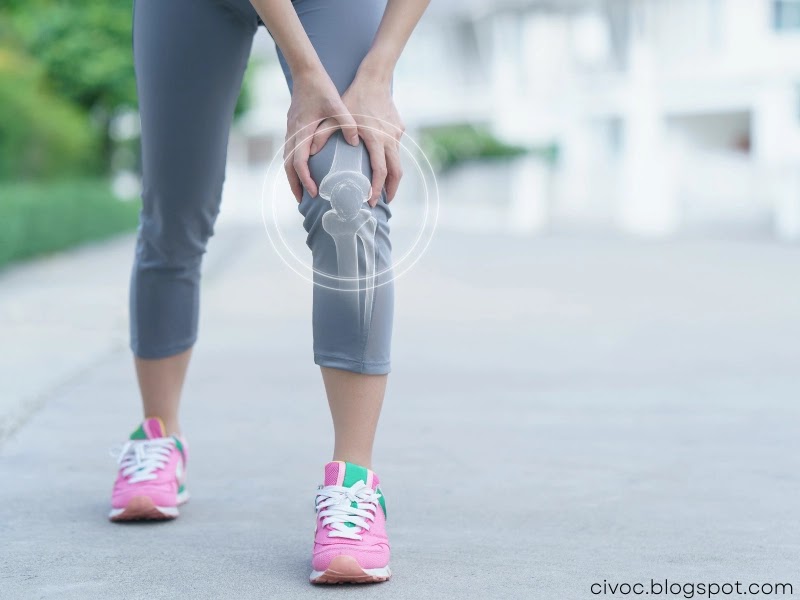Knee Pain When Bending Knee: Causes and Treatments

Knee pain when bending the knee is a common
problem that affects millions of people worldwide at any age.
The knees comprise cartilage, ligaments,
menisci, patella, bones, and muscles. The knees are one of the most complex
parts of the body.
They play a fundamental role in the movement of the legs by allowing walking. The area suffers the most with age, mainly due to cartilage wear.
The knees are the most stressed joints in
our body. We put them under even more pressure if we are overweight or do any
impact sport.
All this makes knee pain when bending the
knee a problem at any age, especially as we age, when diseases affecting the
knee, such as osteoporosis or osteoarthritis, are common.
Knee Pain When Bending Knee
The knee joint comprises bone, cartilage,
ligaments, and fluids. In addition, around it, a series of muscles and tendons
help this joint to move.
When any of these elements suffer damage,
the person may experience pain when bending or stretching. But What causes knee
pain?
What Causes Knee Pain?
Knee pain when bending has many causes
which need to be diagnosed, especially if it does not stop.
However, a widespread type of knee pain
occurs, especially when we bend the knee.
Behind this pain, there can also be many
causes. Let's look at some of the most common ones.
1. Patellofemoral Pain Syndrome (PFPS)
This syndrome occurs mainly due to a
constant knee overload - by sports with impact as running or jumping -but can
also appear after surgery or injuries caused by trauma.
The pain it produces is located in the
front part of the knee, and it is usually mild, but it intensifies notably when
climbing stairs, kneeling, squatting, or sitting with a flexed knee.
X-ray, CT, or MRI should diagnose it, and
it improves with rest or ice after exercise. If the pain is prolonged, the
doctor can prescribe rehabilitation and surgery in severe cases that do not
remit.
2. Patellar Tendinitis
This type of injury causes pain and burning
in the patella and is caused by a wound between the tendon that connects the
patella to the tibia.
At first, the pain starts with or after physical
activity, but over time it can interfere with daily exercise, as it hurts just
by bending slightly when sitting, climbing stairs, or getting up.
This injury is common in people who play
sports that include jumping, such as basketball.
Treatments range from stretching or
rehabilitation to more complex treatments such as steroid or platelet
injections if the tendinitis becomes chronic.
3. Iliotibial Band Syndrome
This syndrome - caused by overloading and
excess friction of the band that connects the buttock to the shin - can cause
pain outside the knee, which extends to the hip or thigh.
At first, it will occur with strenuous
physical activity, such as running, but the pain may occur simply by walking or
climbing stairs over time.
The pain improves with rest or the
application of ice. If it does not stop, it will be necessary to visit a
physiotherapist.
4. Tendinitis of Hamstrings (biceps femoris)
The pain produced by tendinitis in this
area is located behind the knee and may extend to the thigh.
They are usually caused by lousy sports
practices or wrong footwear during the sport. Often improves with rest and
physiotherapy treatments.
5. Tendinitis of the Quadriceps
This type of injury can cause pain in the
upper and front parts of the knee, especially when we move it.
This injury is typical of sports with
frequent acceleration and braking.
The treatment of this injury ranges from
physiotherapy to hyaluronic acid injections or orthopedic braces in the most
complicated cases.
6. Bursitis
This pathology occurs when the bursa, a
small fluid-filled sac that reduces friction and protects the pressure points
between the bones, tendons, and muscles, in this case, of the knee, becomes
inflamed.
In addition to burning and swelling, it
causes pain above and below the knee.
This injury may resolve independently or be
treated with corticosteroid injections or by removing the accumulated fluid
from the knee.
7. Osteoarthritis
Osteoarthritis is caused by joint wear and
tear, resulting in diffuse pain, swelling, and stiffness, especially in the
morning.
Although it may always be present, the pain
worsens when bending the knee and can become sharp and stabbing.
8. Ligament Injuries
The ligaments most commonly injured in the
knee are the anterior cruciate ligament (ACL) and posterior cruciate ligament
(PCL), usually caused by sudden movements.
The pain is acute and hinders movement
since it is sharpened when we bend the knee.
Ice can help relieve the pain; the doctor
may recommend a splint or surgery if it subsides.
9. Baker's Cyst
This pathology, characterized by a
fluid-filled swelling located in the back of the knee, causes pain in this area
and worsens with movement. It can be caused by arthritis.
10. Meniscus Tear
When this cartilage ruptures, which can be
sudden or due to minor injuries or poor posture, in addition to the typical
popping, sharp pain occurs, especially when bending the knees or squatting.
Pain Behind the Knee When Bending
.webp)
The back
Hamstring tendonitis, Baker's cyst.
In the front
Bursitis, quadriceps tendonitis,
patellofemoral pain syndrome, patellar tendonitis.
Above the knee
Quadriceps tendonitis, bursitis,
osteoarthritis.
Acute pain
Ligaments, meniscus tear, osteoarthritis.
Many injuries are preventable with caution,
such as warming up properly or strengthening the area's muscles before impact
exercises.
If they continue to bother, opt for
activities less damaging to the joints, such as cycling and swimming.
Maintaining an appropriate weight also helps prevent knee injuries.
Diagnosis Of Knee Pain When Bending Knee
The doctor's evaluation is based on the
anamnesis (clinical history, symptoms reported by the patient, and lifestyle)
and the physical examination performed in the doctor's office. In addition,
imaging exams are also essential in the diagnosis of the problem.
Magnetic resonance imaging is the exam most
requested by specialists. In more straightforward cases, X-rays are usually
sufficient.
In addition, ultrasound (as in the case of
tendinitis), blood tests (if an inflammatory process is suspected), and
computed tomography (if it is necessary to evaluate the bone part of the knee,
such as when there is femoropatellar instability) can also be requested.
Medical Treatment
Three of the most effective medical
treatments for knee pain when bending the knee are:
Shock Wave
Treatment that uses shock waves to treat
knee pain.
Echo-Guided Percutaneous Electrolysis
Medical treatment is performed with a
needle to relieve knee pain.
Dry Needling
Medical treatment is performed with a
needle to relieve knee pain.
Because of the severe stress on the knee
joint, avoid maximum flexion and squatting when suffering from knee pain. Wear
comfortable shoes, not too high.
Physical therapy and quadriceps exercises
can also help strengthen muscles and prevent knee pain.
Treatment for Knee Pain When Bending the Knee
.webp)
To treat knee pain when bending the knee,
use the "RICE" method. The RICE method stands for the following:
Rest: Rest for the first two or three days,
then gradually resume movement so you don't lose too much muscle strength.
Ice: Apply cold compresses (e.g., ice or a
bag of frozen peas wrapped in a towel) to reduce swelling and bruising. Do not
apply ice directly to the skin, as it can damage it.
Compression: Compress the joint with
bandages to contain the injury and help reduce swelling.
Elevation: Elevate the knee above the level
of the heart and hold it steady.
Exercise for Knee Pain when Bending Knee
Good knee pain management involves moving
more and sitting less. If your knees hurt, staying active will improve your
mobility, function, and mood, a bonus for meeting any challenge.
Depending on the type of injury, the U.S.
Center for Disease Control recommends 150 minutes of physical activity per week
to maintain and promote joint health.
Physical exercises can be very effective in
relieving knee pain over time.
Maintain Healthy Weight
Staying fit and at a healthy weight reduces
the load on your joints, especially your knees.
Be sure to eat a balanced diet and be
physically active to maintain a healthy weight and delay treatment as much as
possible.
Thermotherapy
Alternating cold with heat can reduce
stiffness and increase the mobility of the knee joints.
As part of your treatment for knee pain, we
recommend taking a warm shower in the morning and using a warm blanket or
heating pad at night when you go to bed, a ritual that will do your mood and
joints good.
Applying colds also relieves inflammation
in the knees. Wrap a cold gel pack in a towel and use it on your knee for 20
minutes daily.
Dietary Changes
Diet influences your body and mood, so
logically, the potential of certain foods to reduce pain is being investigated.
Increasing the consumption of foods rich in
omega-3 fatty acids, such as Virgin olive oil, Turmeric, Walnuts, Chia seeds,
Flaxseed, and Oily fish, may be advisable.
How To Recover from Knee Pain When Bending the Knee?
Good habits and the help of a
traumatologist or a physiotherapist are essential for knee injury recovery.
Foods rich in protein, antioxidants, nuts,
and cold-pressed oil are necessary to manufacture new tissues, muscles, bones,
and joints.
In addition, daily sun exposure stimulates
the production of vitamin D, a shortage of which can cause knee pain.
How To Prevent Knee Pain When Bending the Knee?
The practice of some sports, such as
running, cycling, or swimming, strengthens the knees.
If you do not have time to do these
activities, you can opt for practical exercises to avoid pain in these joints
and take care of them without having to leave home:
Lunges or strides: with an upright
position, place one leg behind and the other, bent, in front and lower the
front knee to the ground.
This exercise works the leg muscles and
strengthens the entire knee.
Knee-to-chest exercise: With your body
lying on the floor, bend your knees until you bring them as close to your chest
as possible.
You exercise your knees and quadriceps by
holding your legs with your hands.
Squats: Work the torso, knees, and lower
body.
When to go to the doctor?
You should see your doctor if you
experience the following symptoms of knee pain:
- Your knees can't support your weight.
- Knee instability or feeling your knee is about to give way.
- Noticeable swelling of the knee.
- Obvious deformity of the leg or knee.
- Redness, pain, and swelling in the knee accompanied by fever.
- Persistent pain that does not improve in a few days.
Knee Pain When Bending Knee FAQs
How is the pain with the meniscus?
Symptoms of meniscus tear when the outer
(lateral) meniscus is damaged:
Pain when rotating the knee inward
(internal rotation).
Pain when putting pressure on the lateral
knee joint socket (can be felt with fingers) and when squatting.
Why can't I bend my knee?
The knee cannot bend and straighten, and
sometimes there is pain when bending the knee and swelling.
A damaged meniscus or a free joint body
usually causes obstruction. In case of sudden inhibition of extension, the knee
cannot fully extend.
When should you go to the doctor with Knee Pain when Bending your Knee?
You should see a physical therapist
immediately if the knee is red, overheated, swollen, or unstable or if there
are crunching noises.
Even if you can no longer put weight on the
knee due to severe pain, a specialist should examine the knee joint.
What if you have pain in the hollow of the knee?
Pain and an unpleasant feeling of tightness
in the hollow of the knee may indicate a Baker's cyst.
A Baker's cyst is located in the hollow of
the knee and is a fluid-filled lump. In medical terminology, the cyst is also
called a popliteal cyst.
Final Thought
Knee pain when bending the knee has many
causes, including injury, overuse, and underlying medical conditions.
To prevent knee pain when bending the knee,
practicing some sports, such as running, cycling, or swimming, strengthens the
knees.
Consulting a doctor is the best option. It is much better than resigning yourself to living with pain. The sooner you find a pain treatment to help you regain control, the sooner you can return to enjoying movement.



